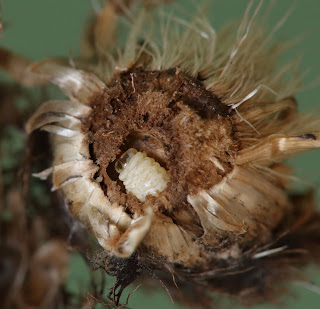One of the highlights has been another site for Phyllonorycter ulicicolella, on Frilford Heath golf course (VC22) at the weekend. There's a reasonable amount of gorse here that's been retained around the edges, and I checked 3 of the scragglier bushes (which this species seems to like) and found mines on all of them (a total of 19). If others are interested in looking for this species, I did a blog with some very tentative (!) thoughts about finding it here: https://willsbutterflies.blogspot.com/2020/12/finding-phyllonorycter-ulicicolella-and.html. Basically I've found it most places there is gorse that I've checked (so it's probably a bit more widespread than records suggest), and I find most mines on the more woody, straggly bushes (but others have found them on younger growth).
 |
| Phyllonorycter ulicicolella larva in the mine |
Other miners I've found have been the oak-bark Zimmermannia (formerly Ectoedemia) species in Bernwood - longicaudella/atrifrontella, Trifurcula immundella's mines on Broom at Frilford Heath (another one that's worth looking for wherever the foodplant occurs), and Bucculatrix nigricomella, which is just starting to mine Oxeye Daisy now.
 |
| Bucculatrix nigricomella mine |
I've also found a few species mining in branches, including Spuleria flavicaput (mining Hawthorn branches) and Orange-Tailed Clearwing (old galls in Wayfaring Tree stems) at Sydlings Copse
 |
| Old Orange-Tailed Clearwing gall |
I haven't had too much luck with species that can be found in seedheads over the winter. I've tried to find Metzneria lappella (Burdock) and aestiviella (Carline Thistle), but no luck so far. I did find Metzneria metzneriella in Common Knapweed at Chilswell Valley though, as well as Endothenia gentianaenea in Teasel. The former took 134 seedheads to find, but the latter is very easy to find (I never normally need to check more than 2 or 3 teasel heads) but takes care to separate from the similar marginana, by the absence of the anal comb. Another easy one to find in seedheads at the moment is Limnaecia phragmitella on Bulrush. The presence of larva (which are often present in large numbers) is given away by white down puffing out of the seedheads (held there by silk produced by the larvae), and just opening up the seedhead a bit normally reveals them.
 |
| Metzneria metzneriella larva |


I have spent a couple of hours searching through masses of dead oak leaves, but have not so far found any mines. Perhaps I have the wrong "search image", so I wonder whether you have any images you could post of dead oak leaves with active mines? All I could find online was mines in fresh leaves!
ReplyDeleteThanks
Phil Tizzard
Hi Phil, I don't actually, but will try and take some for you and post them here. The mines fade a lot and can be tricky to spot on the fallen leaves. I was a bit surprised by this, given how obvious and abundant Phyllos are on green oak leaves in summer, I reckon it takes me about an hour to find about 20 mines in fallen leaves. I think one tip might be to search for distorted leaves with unusual shapes (indicating a mine underneath), but they are tricky.
ReplyDeleteThanks. I did find just one leaf with a rolled edge but it turned out to be just that...a leaf with a rolled edge!
ReplyDeleteMany thanks for posting this here, Will. Some useful things to look for there and I really must get out to search for Phyllonorycter ulicicolella. The ease with which you seem to be finding it just over the border in Oxon means that it surely must be present in Bucks too, although as yet there have been no records. There are some sites not too far from me with plenty of gorse and I shall have to make the effort, although it must be one of the meanest food-plants to search - I'll have to remember to take some heavy-duty gloves!
ReplyDeleteMy pleasure Dave! I'm sure it's out there somewhere. Back in Somerset I also found it at fairly isolated sites with small amounts of gorse. I've been meaning to try Bernwood for it (think I've seen some gorse in the eastern part of the forest?).
Delete